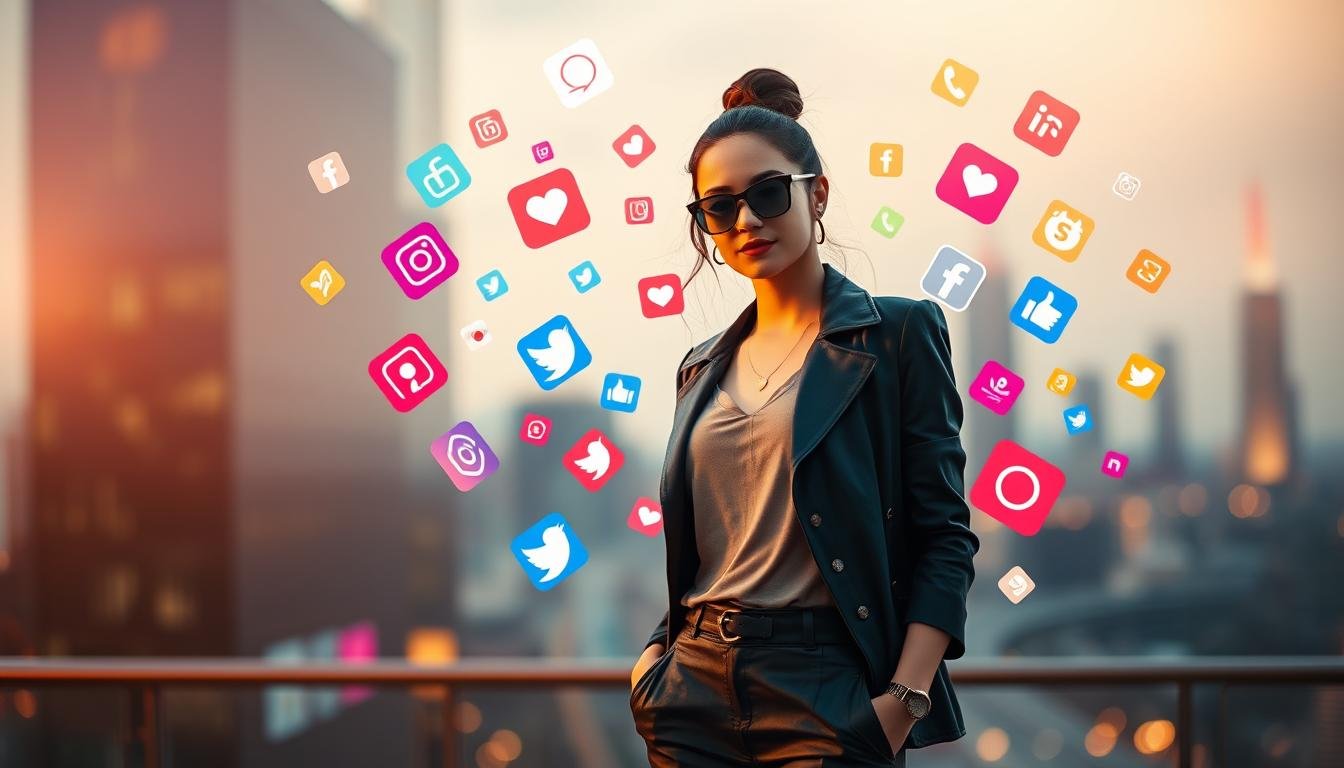Did you know that businesses can see up to $6.50 in revenue for every dollar invested in influencer marketing? This impressive return on investment showcases the power of teaming up with influencers to connect with your audience. In today’s digital world, brand partnerships with influencers can greatly boost a company’s online image.
As social media keeps evolving, the role of digital marketing strategies that include influencer collaborations becomes more critical. This piece will dive into the advantages and best methods of influencer marketing. It aims to shed light on how companies can use these partnerships to fuel their growth.
Key Takeaways
- Understanding the ROI of influencer marketing
- Finding the right influencers for your brand
- Best practices for successful influencer collaborations
- Measuring the success of influencer marketing campaigns
- Using influencer marketing to improve brand presence
The Fundamentals of Influencer Marketing
Influencer marketing has seen a significant transformation over the years, adapting to the digital landscape’s evolution. At its essence, it involves partnering with individuals who have a significant following on social media or blogs. These influencers have earned the trust and credibility of their audience, making their endorsements highly valuable.
Definition and Core Concepts
Influencer marketing relies on social proof, where influencers’ actions sway their followers’ purchasing decisions. It’s about teaming up with the right influencers to promote products or services.
What Makes Someone an Influencer
An influencer is someone who has amassed a substantial and engaged following across various social media platforms. Their expertise and authenticity in a specific niche make their opinions influential.
The Psychology Behind Influencer Impact
The influence of influencers comes from the trust they’ve built with their audience. Followers see influencers as relatable figures, making their recommendations more compelling.
The Evolution of Influencer Marketing
Influencer marketing has evolved from traditional celebrity endorsements to social media influence.
From Celebrity Endorsements to Social Media Influence
The shift to social media has democratized influencer marketing. Now, individuals with niche followings can become influential.
Current Trends Shaping the Industry
Current trends include the rise of micro-influencers and a focus on authenticity and transparency in influencer collaborations.
Why Influencer Marketing Matters in Today’s Digital Landscape
In today’s digital world, influencer marketing has become a key strategy for brands aiming to connect with their audience.
The growing distrust of traditional brand messages has shifted how consumers interact with brands. This shift makes influencer outreach and influencer strategy vital for a brand’s marketing efforts.
Consumer Trust and Authenticity
Consumers now seek authenticity in the brands they choose to engage with. Influencer marketing offers a solution by partnering with individuals who have earned their audience’s trust.
The Decline of Traditional Advertising Effectiveness
Traditional advertising’s effectiveness is waning as consumers become more informed and skeptical of brand messages.
How Influencers Build Credibility with Audiences
Influencers gain credibility by consistently producing high-quality content that resonates with their audience. This fosters trust and authenticity.
Reach and Engagement Benefits
Influencer marketing allows brands to tap into niche and targeted audiences, leading to higher engagement rates than brand-created content.
Accessing Niche and Targeted Audiences
Influencers can reach specific demographics and interests, enabling brands to target their marketing more effectively.
Engagement Rates Compared to Brand-Created Content
Influencer-created content typically sees higher engagement rates due to the personal connection between the influencer and their audience.
ROI (Return on Investment) Compared to Traditional Marketing
Influencer marketing offers a cost-effective solution for small to medium businesses, promising a strong ROI.
Cost-Effectiveness for Small to Medium Businesses
Influencer marketing allows smaller businesses to reach their target audiences without the high costs of traditional marketing.
Long-Term Value of Influencer Relationships
Building long-term relationships with influencers can lead to sustained brand awareness and ongoing engagement.
| Benefits of Influencer Marketing | Traditional Marketing | Influencer Marketing |
|---|---|---|
| Consumer Trust | Low | High |
| Reach and Engagement | Limited | High |
| Cost-Effectiveness | Low | High |
Types of Influencers and Their Impact
Influencers vary from mega-influencers to nano-influencers, each with a unique role in marketing. It’s essential for brands to grasp these differences to effectively use influencer marketing.
Mega-Influencers vs. Micro-Influencers
Mega-influencers, often celebrities or well-known figures, boast large followings. They’re perfect for campaigns aiming for wide brand awareness.
When to Use Celebrities and Major Influencers
Celebrities excel in campaigns needing broad reach and brand recognition. Their massive followings can swiftly amplify a brand’s message.
The Engagement Advantage of Micro-Influencers
Micro-influencers, with smaller but highly engaged audiences, provide a targeted approach. They generally have higher engagement rates than mega-influencers.
Nano-Influencers and Their Growing Importance
Nano-influencers have smaller, niche audiences. Their growing importance stems from their specialized and engaged follower base.
Identifying Potentials in Small but Mighty Voices
Brands should seek out nano-influencers with a genuine connection to their audience. They offer targeted marketing opportunities.
Cost-Benefit Analysis of Nano-Influencer Campaigns
Nano-influencer campaigns are cost-effective, providing high engagement rates at lower costs than mega-influencers.
Industry-Specific Influencers
Industry-specific influencers are experts in particular niches. They bring credibility and targeted reach.
Finding Thought Leaders in Your Niche
Identifying thought leaders in your industry can boost a brand’s credibility and trust with the target audience.
Leveraging Expert Credibility
Partnering with industry-specific influencers taps into their expertise. This enhances the brand’s credibility.
Setting Clear Goals for Your Influencer Marketing Strategy
At the heart of a successful influencer marketing strategy lies clear objectives. By defining specific, measurable goals, brands can better navigate the complexities of influencer partnerships. This approach ensures they achieve their desired outcomes.
Brand Awareness Objectives
Increasing brand awareness is a primary goal of influencer marketing. It aims to make your brand more recognizable and familiar to your target audience.
Measuring Visibility and Reach Metrics
To assess the success of brand awareness campaigns, focus on metrics like impressions, reach, and views. These metrics offer insights into the number of people exposed to your brand.
Setting Realistic Awareness Targets
It’s essential to set achievable targets based on your current brand visibility and marketing budget. Realistic goals ensure a focused strategy.
Conversion and Sales Goals
Influencer marketing can also drive conversions and sales. This requires creating a seamless path from influencer content to your website or store.
Creating Trackable Conversion Paths
Utilize trackable links and promo codes to monitor the effectiveness of influencer campaigns in driving sales. This allows for attributing sales to specific influencers or campaigns.
Attribution Models for Influencer Sales
Implementing the right attribution models is critical to understanding influencer marketing’s contribution to your sales funnel. Options include last-click, first-click, or multi-touch attribution models.
Content Creation and Audience Building
Influencer marketing also focuses on creating high-quality content and building a community around your brand. Influencers can produce engaging content that resonates with their followers.
Repurposing Influencer Content Across Channels
Maximize the value of influencer content by repurposing it across your own marketing channels. This can include social media posts, blog features, or email newsletters.
Community Growth Strategies
Leverage influencers to grow your community by encouraging engagement and fostering a loyal following. This involves working with influencers who align with your brand values.

How to Identify the Right Influencers for Your Brand
Finding the right influencers for your brand is key to successful influencer marketing. It requires a detailed analysis to ensure the influencers you choose match your brand’s goals. Their audience and content should align with your objectives.
Audience Alignment Analysis
Audience alignment is vital to ensure your message reaches the right people. Demographic and psychographic matching techniques are essential for this analysis.
Demographic and Psychographic Matching Techniques
Demographic matching looks at age, gender, location, and more. Psychographic matching examines interests, values, and lifestyle. Together, they help determine if an influencer’s audience matches your target market.
Tools for Audience Overlap Assessment
Tools like social media analytics and influencer marketing software help assess audience overlap. They provide insights into an influencer’s audience demographics, helping identify overlaps with your target audience.
Content Quality and Style Assessment
Evaluating an influencer’s content quality and style is critical. It ensures their content meets your brand’s standards. This includes both visual and written content.
Evaluating Visual and Written Content Standards
Quality content goes beyond looks; it’s about relevance and consistency. Choose influencers with a consistent tone and style that matches your brand’s voice.
Brand Voice Compatibility Checklist
A checklist for brand voice compatibility can streamline the selection process. Consider tone, language, and core values.
“The right influencer is not just someone with a large following, but someone whose values and content align with your brand.”
Engagement Rate Evaluation
Engagement rate is a key metric. It shows how actively an influencer’s audience interacts with their content.
Calculating True Engagement Beyond Vanity Metrics
True engagement goes beyond follower count. It includes likes, comments, shares, and more. Understanding an influencer’s actual reach and impact is essential.
Red Flags for Fake Engagement
Be cautious of influencers with unusually high engagement rates or a history of buying followers. Tools that analyze engagement patterns can spot fake engagement.
Building an Effective Influencer Outreach Strategy
Creating a compelling influencer outreach strategy is essential for successful brand partnerships. Brands must focus on making personalized connections with influencers. They need to understand their content and align it with their marketing goals.
Crafting Compelling Outreach Messages
The first step is crafting a message that resonates with the influencer. This requires personalization techniques that show you’ve taken the time to understand their work.
Personalization Techniques That Get Responses
Using the influencer’s name and referencing their recent work can significantly increase response rates. Tailoring your proposal to their niche is also key. For instance, addressing the influencer by name and commenting on a recent post can make the message feel more personal.
Subject Lines and Message Templates That Work
Effective subject lines are concise and relevant. Message templates should be flexible for personalization. A good template might start with a compliment on the influencer’s work, followed by a clear proposal.
Establishing Mutually Beneficial Relationships
A successful influencer partnership is based on mutual benefit. Brands must understand what they can offer influencers in return for their collaboration.
Value Proposition Development for Influencers
Developing a strong value proposition involves understanding the influencer’s audience and content style. Then, align your brand’s offerings to match. This could be exclusive content, monetary compensation, or increased exposure.
Building Long-Term Partnerships vs. One-Off Campaigns
While one-off campaigns can be effective, long-term partnerships offer sustained brand awareness and credibility. Long-term collaborations allow for more authentic content and a deeper connection with the influencer’s audience.

Following Up Without Being Pushy
Following up with influencers is essential, but it must be done without being overly aggressive. Timing and frequency are key.
Timing and Frequency Best Practices
A good rule of thumb is to wait a week or two before sending a follow-up message. The message should be polite and brief, reiterating the initial proposal.
Alternative Approach Strategies When Initial Contact Fails
If the initial contact doesn’t yield a response, consider alternative strategies. Engaging with the influencer’s content on social media or commenting on their posts can help. This keeps your brand top of mind without being intrusive.
| Outreach Strategy | Description | Benefits |
|---|---|---|
| Personalized Messages | Tailoring messages to individual influencers | Increased response rates, stronger connections |
| Value Proposition | Offering benefits to influencers for collaboration | Mutually beneficial partnerships, higher quality content |
| Long-Term Partnerships | Building sustained relationships with influencers | Deeper audience connection, sustained brand awareness |
Creating Successful Influencer Campaigns
Effective influencer campaigns rely on clear goals, compelling content, and strategic partnerships. Brands must plan and execute their influencer marketing strategies with care.
Campaign Brief Development
Creating a detailed campaign brief is essential. It sets the tone and direction for your influencer campaign. A well-crafted brief ensures influencers grasp your brand’s objectives and messaging.
Essential Elements of an Effective Brief
An effective brief must include campaign objectives, target audience, and key messaging. It should also outline expected outcomes and deliverables.
Balancing Direction with Creative Freedom
It’s vital to provide influencers with clear direction while also giving them creative freedom. This balance is key to a successful campaign.
Content Guidelines and Brand Alignment
Clear content guidelines are critical for maintaining brand consistency. They ensure influencer content aligns with your brand’s messaging. Style guides and approval processes are essential.
Creating Style Guides for Influencers
A style guide helps influencers understand your brand’s visual identity and tone. It enables them to create content that resonates with your audience.
Approval Processes That Maintain Authenticity
An approval process that respects the influencer’s creative input while ensuring brand alignment is vital. Regular check-ins and feedback loops are key.
Timeline and Deliverables Management
Managing the timeline and deliverables of an influencer campaign is critical. This involves setting realistic deadlines and coordinating content calendars.
Setting Realistic Deadlines and Milestones
Clear deadlines and milestones keep the campaign on track. They ensure all parties are aware of their responsibilities and timelines.
Content Calendar Coordination Strategies
Coordinating content calendars with influencers is essential. It helps plan and schedule content in advance, ensuring a consistent flow of messaging.
By focusing on these key areas, brands can create successful influencer campaigns. These campaigns drive engagement, boost brand awareness, and lead to conversions.
Compensation Models in Influencer Marketing
Influencer marketing is expanding, making it vital for brands to grasp the various compensation models. The choice of compensation structure can greatly influence the success of collaborations with influencers.
Monetary Compensation Structures
Monetary compensation is a clear-cut method where influencers receive direct payment for their work. This can take the form of a fixed fee or a payment based on performance.
Flat Fee vs. Performance-Based Payment
A flat fee means paying the influencer a set amount, regardless of the campaign’s outcome. On the other hand, performance-based payment rewards influencers based on metrics like engagement or sales.
Rate Negotiation Strategies
When negotiating rates, understanding the brand’s budget and the influencer’s value is key. Being open and adaptable during negotiations is critical to securing a fair agreement for both parties.
Product-Based Partnerships
Product-based partnerships compensate influencers with goods or services instead of cash. This model is beneficial for brands with tight budgets or when the product fits well with the influencer’s audience.
When Product Exchanges Make Sense
Product exchanges work best when the brand’s product resonates with the influencer’s niche and audience. This approach fosters authentic content and strengthens the brand-influencer bond.
Adding Value Beyond Free Products
To enhance the partnership, brands can offer more than just free products. Providing exclusive experiences or early access to new products can make the collaboration more appealing to the influencer.

Affiliate and Commission-Based Models
Affiliate and commission-based models reward influencers for driving sales. They earn a commission for each sale made through their unique referral link or discount code.
Setting Up Tracking Links and Discount Codes
To start an affiliate model, brands must create tracking links and discount codes for influencers to use. This setup allows for precise tracking of sales attributed to each influencer.
Commission Structures That Motivate Performance
Creating a commission structure that motivates influencers involves setting competitive rates and possibly bonuses for hitting sales targets. This approach encourages influencers to perform well.
Legal Considerations and Disclosure Requirements
Influencer marketing’s growth highlights the need to grasp legal aspects and disclosure rules. Brands must navigate a complex legal terrain to stay compliant and keep their audience’s trust.
FTC Guidelines for Influencer Partnerships
The Federal Trade Commission (FTC) has set guidelines for influencer partnerships. These are vital for brands to follow, ensuring transparency and fairness in advertising.
Clear Disclosure Requirements and Examples
The FTC demands clear disclosure of any material connection between influencers and brands. This can be done using phrases like “Ad,” “Sponsored,” or “Partner.” For instance, influencers might use #ad or #sponsored in their posts to signal sponsored content.
Consequences of Non-Compliance
Ignoring FTC guidelines can lead to severe penalties, including fines and harm to a brand’s reputation. Both influencers and brands face liability for non-compliance.
Contract Elements and Intellectual Property Rights
A solid contract is key for influencer partnerships. It must safeguard both the brand’s and the influencer’s interests, focusing on intellectual property rights.
Essential Clauses for Influencer Agreements
Influencer agreements should detail the scope of work, content requirements, and compensation. These clauses ensure both parties understand their roles and expectations.
Content Usage Rights and Limitations
Contracts must outline content usage rights and limitations. This includes how the brand can use the content, for how long, and in what contexts.
Measuring the Success of Your Influencer Marketing
Unlocking the full power of influencer marketing requires precise measurement of campaign success. Brands must identify and track the most relevant metrics to achieve this.
Key Performance Indicators (KPIs)
KPIs are essential for evaluating the success of influencer marketing campaigns. They offer insights into how well a campaign meets its objectives.
Awareness Metrics That Matter
Awareness metrics, such as reach and impressions, are critical. They show how many people have seen the campaign. These metrics are key to measuring brand visibility.
Engagement and Conversion Tracking
Engagement metrics (likes, comments, shares) and conversion tracking (sales, sign-ups) are vital. They reveal how the audience interacts with the campaign and if it drives desired actions.
Analytics Tools and Tracking Methods
Choosing the right analytics tools is vital for collecting and analyzing campaign data.
Platform-Specific Analytics Features
Most social media platforms have built-in analytics features. These provide insights into campaign performance, tracking engagement, reach, and more.
Third-Party Measurement Solutions
Third-party tools offer deeper insights and track campaign performance across various platforms. They provide advanced analytics and reporting capabilities.
Calculating ROI from Influencer Campaigns
Calculating ROI from influencer campaigns requires evaluating both direct and indirect value. Direct value includes immediate sales or conversions, while indirect value encompasses long-term brand awareness and customer loyalty.
Reporting Templates and Dashboards
Using reporting templates and dashboards simplifies tracking and presenting campaign results. They make data visualization easier, aiding in understanding campaign performance.
| Metric | Description | Importance |
|---|---|---|
| Reach | Number of people who viewed the campaign | High |
| Engagement | Likes, comments, shares on campaign content | High |
| Conversion | Sales, sign-ups, or other desired actions | High |
Common Challenges in Influencer Marketing and How to Overcome Them
Influencer marketing faces hurdles like fake followers and keeping content authentic. Brands must tackle these issues to make their campaigns successful.
Fake Followers and Engagement
Fake followers and engagement are major hurdles in influencer marketing. It’s vital for brands to check if an influencer’s followers are real.
Tools for Authenticity Verification
Tools like HypeAuditor or Social Blade help analyze followers and engagement. They can spot fake or bought followers.
Red Flags in Influencer Profiles
Look out for sudden follower spikes, low engagement with many followers, and inconsistent engagement patterns. These are red flags.
Maintaining Authenticity in Sponsored Content
Authenticity is key for sponsored content success. Influencers must blend their creative voice with brand needs.
Balancing Brand Requirements with Creator Voice
Brands should let influencers create content that fits their style. This ensures sponsored posts feel natural, not forced.
Examples of Natural Integration vs. Forced Promotion
A beauty influencer naturally using a skincare product is better than a forced ad. Natural integration wins over forced promotion.
Managing Influencer Relationships Long-Term
Long-term influencer management is critical for campaign success. Regular communication and clear expectations are essential.
Communication Cadence Best Practices
Regular updates and check-ins keep brand-influencer relationships strong. This ensures both are on the same page about campaign goals.
Exclusivity Considerations and Competitor Management
Brands must think about exclusivity and manage competitor relationships. This avoids conflicts of interest.
| Challenge | Strategy to Overcome |
|---|---|
| Fake Followers | Use authenticity verification tools |
| Maintaining Authenticity | Balance brand requirements with creator voice |
| Managing Long-Term Relationships | Regular communication and clear expectations |
Conclusion
The strength of influencer marketing comes from its ability to bridge brands with their target audiences in a genuine way. This article has delved into the different aspects of influencer marketing. We’ve covered everything from its basics to the tactics for running effective campaigns.
Choosing the right influencers is key. They should match your audience, offer high-quality content, and have strong engagement. Building relationships that benefit both parties and managing campaigns well are also vital. These steps help meet marketing objectives.
“Influencer marketing is not just about reaching a large audience; it’s about connecting with the right people in an authentic way.” –
As brands move through the digital world, using influencer marketing can greatly enhance their marketing strategies. By implementing the strategies we’ve discussed, businesses can increase brand visibility, drive sales, and enhance their return on investment.
| Strategy | Benefit |
|---|---|
| Influencer Selection | Targeted Audience Reach |
| Campaign Management | Improved Engagement |
| Authentic Content | Enhanced Brand Credibility |
Sources
For further information on influencer marketing, the following resources provide valuable insights:
- Influencer Marketing Association: A detailed resource for grasping the influencer marketing landscape.
- Federal Trade Commission (FTC) Endorsement Guides: Essential guidelines for influencers and brands on compliant sponsored content.
- Deloitte Digital Marketing Trends: Industry insights and trends in digital marketing, including influencer marketing.
These sources offer a solid foundation for exploring the complexities and opportunities in influencer marketing.
FAQ
What is influencer marketing, and how does it work?
Influencer marketing involves brands teaming up with individuals who have a large following on social media or blogs. These partnerships aim to promote products or services. It leverages the influencer’s credibility and reach to boost brand awareness, engagement, and conversions.
Why is influencer marketing important in today’s digital landscape?
In today’s digital world, influencer marketing is key. It enables brands to connect with their audience in a genuine and engaging manner. Influencers have earned the trust of their followers, making their endorsements more impactful than traditional ads.
What are the different types of influencers, and how do I choose the right one for my brand?
There are various influencer types, including mega-influencers, micro-influencers, and nano-influencers. When selecting, consider factors like audience alignment, content quality, and engagement rates. Micro-influencers, for instance, often boast higher engagement and are more budget-friendly for smaller brands.
How do I measure the success of my influencer marketing campaigns?
To gauge the success of your influencer marketing, focus on key performance indicators (KPIs) like reach, engagement, conversions, and ROI. Utilize analytics tools to monitor campaign performance and refine your strategy as needed.
What are the legal considerations for influencer marketing, and how do I ensure compliance?
Influencer marketing comes with legal hurdles, including FTC guidelines for disclosure and intellectual property rights. Ensure compliance by clearly labeling sponsored content, using proper contract language, and respecting intellectual property rights.
How do I build an effective influencer outreach strategy?
To craft an effective influencer outreach strategy, start with compelling messages and aim to build mutually beneficial relationships. Personalize your outreach and focus on long-term partnerships with influencers. Follow up without being overly aggressive.
What are the different compensation models used in influencer marketing?
Influencer marketing compensation models vary, including monetary structures, product partnerships, and affiliate models. Select a model that fits your campaign goals and budget. Negotiate rates based on the influencer’s reach, engagement, and content quality.
How do I maintain authenticity in sponsored content?
To keep sponsored content authentic, ensure the influencer’s voice and style match your brand’s messaging. Provide clear guidelines but also grant creative freedom. This allows influencers to create content that resonates with their audience.
